Physical Address
304 North Cardinal St.
Dorchester Center, MA 02124
We sincerely thank Drs. Shigehiko Shionoya and Jeffrey W. Olin, the authors of this chapter in previous editions, for their outstanding work, which has provided invaluable insights into Buerger disease, and Drs. Isinsu Kuzu and Suat Aytac of the Ankara University School of Medicine for their scientific assistance and the provision of pathology and radiology illustrations, and Kanat Akar for algorithm illustrations.
Thromboangiitis obliterans (TAO), also known as Buerger disease (BD) or von Winiwarter–Buerger syndrome, is a rare inflammatory, nonatherosclerotic, occlusive, peripheral vascular disease primarily involving infrapopliteal and infrabrachial medium and small-sized arteries and veins. It is predominantly a disease of young men, with onset typically before the age of 45 to 50 years. The prevalence in women, however, has been increasing related to increased tobacco use. , , , The disease is more common among people of the Middle East, Asia, Mediterranean region, and Eastern Europe but is rare in Africa, Western Europe, and North America. TAO is typically manifested by distal extremity ischemia involving the feet, legs, or hands leading to critical limb ischemia (CLI), ischemic ulcerations, digital gangrene, and limb infection. , ,
TAO develops as a response to environmental factors primarily with smoking, resulting in major and minor amputations with a high degree of morbidity and disability resulting in unemployment, psychological, behavioral, social, and financial costs. , Pathologically, TAO is characterized by a highly inflammatory thrombus and preservation of all layers of the arterial wall, including internal elastic lamina. , The disease frequently involves adjacent or superficial veins and nerves. TAO has been classified under non-necrotizing, non-granulomatous, medium, and small-vessel vasculitis. However, TAO has not been included in the revised 2012 Chapel Hill consensus conference nomenclature of vasculitiis. , Absence of markers of inflammation and autoantibodies is unique for TAO compared to other types of vasculitis. , Patients experience periods of acute exacerbation leading to CLI associated with smoking. Remissions follow abstinence from tobacco or occur in the fifth to sixth decades of life. Rare reports of cerebral, coronary, visceral, ophthalmic, and multi-organ involvements have also been described. Reduction in the extremity amputation rate can be achieved by smoking cessation. For optimal outcomes, an interdisciplinary care team approach is required for the management of TAO patients.
Reports resembling TAO have appeared in medical writings since the mid-1800s, but the cases were labeled arteriosclerosis obliterans (ASO) or frostbite because of the lack of pathologic confirmation. In 1879, Felix von Winiwarter described a 57-year-old man with a lengthy history of foot pain that eventually progressed to gangrene and limb loss, which is now recognized as the first published case of a patient with CLI. , , In 1898, Haga reported similar clinical features resulting in spontaneous gangrene. In 1908, Leo Buerger described a new and unusual form of progressive vaso-occlusion in Polish and Russian immigrants who underwent amputation for “Spontan-gangrän” . Based on his findings, Buerger called the disease “ thromboangiitis obliterans ” to distinguish it from ASO. Subsequently, Buerger emphasized the association of migrating thrombophlebitis with thrombo-angoiitis. Buerger’s 32-chapter, 628-page monograph entitled “ The Circulatory Disturbances of the Extremities ” was published in 1924. Allen and Brown reviewed 200 patients diagnosed with TAO who were evaluated at the Mayo Clinic from 1922 to 1926. However, between the 1930s and 1960s, numerous investigators expressed skepticism concerning the identity of TAO. In the early 1960s, several authorities considered TAO a distinct diagnosis that should be separated from ASO. Today, TAO is accepted as a definite medium and small-vessel vasculitis with a typical clinical picture, natural history, and histopathology. , , , , ,
According to the World Health Organization (WHO), there are currently an estimated 1.3 billion smokers globally, and over 80% live in low- and middle-income countries. TAO is found worldwide and affects both sexes and all races; however, the incidence varies by geographic location, , , , , , and uneven gender distribution. , Buerger’s view of the disease as being restricted mainly to the Jewish race is no longer valid. , TAO is more common in the Middle East, Asia, the Mediterranean, and Eastern Europe but is rare in Africa, central Europe, and North America. The prevalence of TAO among all patients with peripheral arterial disease varies throughout the world; 0.75% in North America, 0.5 to 5.6% in Western Europe, 3%–39% in Eastern Europe, 6.6% in Turkey, 80% Israel among Jews of Ashkenazi ancestry, 16% in Japan, 66% in Korea, and 45%–63% in India. , ,
TAO has a striking predominance in men, especially in series reported before 1960. The reported incidence of TAO in women was less than 1% in most published series in that era. Indeed, only two of Buerger’s 500 reported cases were women. However, TAO is no longer exclusively seen in the male population. , Rising use of tobacco products by young women lead to the decrease in gender differences in the current series, in which 9.8% to 30% of patients were women. , , , , Currently, TAO affects men at a 4-fold to a 10-fold higher rate than women. , , , , , A limited number of pregnancies among patients with active TAO has also been reported.
There was an 8-fold decrease in the annual incidence of TAO at the Mayo Clinic (from 104 in 1947 to 12.6 in 1986, per 100,000 patient registrations). , The number of new patients with TAO in Japan has also been decreasing ; the ratio of TAO to ASO patients has declined from 1:3 in the 1990s to 1:10 after 2000 in Japan. Currently, TAO affects approximately 10 in 100,000 people in the European Union (estimated from the applications to the Committee for Orphan Medicinal Products). The number of patients affected by TAO is estimated at 51,000 in the European Union, and 4000 in Japan. The pooled characteristics of patients with TAO are listed in Table 139.1 .
| Prevalence | Uncommon |
| Prevalence in woman | Increasing |
| Incidence | Declining |
| Involved arterial size | Medium and small |
| Age at onset of symptoms (years) | 29–44 |
| Age at diagnosis (years) | 29–42 |
| Age at hospital admission (years) | 42.5± 8.4 |
| Male, % Female, % |
77–98 2–23 |
| History of tobacco smoking, % | 93–98.7 |
| History of cannabis smoking, % | 22.8 |
| Familial history, % | 1–6.7 |
| Intermittent claudication, % | 17–62 |
| Upper limb only, % | 1.8 |
| Lower limb only, % | 41.5 |
| Both upper and lower limb, % | 7.1 |
| Rest pain, % | 13–89 |
| Upper limb only, % | 26.3 |
| Lower limb only, % | 37.5 |
| Both upper and lower limb, % | 7.1 |
| Ischemic ulcers and gangrene, % | 31.5–85 |
| Upper limb only, % | 8.5 |
| Lower limb only, % | 19.2 |
| Both upper and lower limb, % | 3.1 |
| Limb infection | 8.8 |
| Migratory superficial phlebitis, % | 16–62 |
| Deep vein thrombosis, % | Unusual |
| Raynaud phenomenon, % | 10–45 |
| Sensory findings, % | 69 |
| Abnormal Allen test, % | 63 |
| Joint manifestations, % | 7.6–12.5 |
The only risk factor consistently reported is smoking. The strong correlation between tobacco use and the pathogenesis, initiation, and progression of the disease is well established. , , , , , There is also a higher incidence of TAO among individuals with cigar and pipe smoking; habitual home-made cigarette smoking such as “bidi” smoking in India, Bangladesh, and Ceylon ; “ kawung ” smoking in Indonesia , ; and chewed “ miang ” (steamed tea leaves) or “ khiyo ” (the home-made raw tobacco in hand-rolled banana leaves) smoking in Thailand, or mixing cannabis with tobacco in hand-rolled cigarettes in France as well as in users of smokeless tobacco and marijuana. , Lower socioeconomic status, poor oral hygiene, nutritional deficits, a history of viral or fungal infection, cold injury, abuse of sympathomimetic drugs, and arsenic intoxication are reported as other possible risk factors. , , An emerging body of evidence demonstrates that ischemia induced by cocaine, amphetamines, and cannabis addiction can closely mimic TAO symptoms or may accelerate TAO onset and presentation. Furthermore, a close relation between long-term arsenic exposure from artesian well water and endemic Blackfoot disease has been reported in Taiwan. , In fact, arsenic adulteration of tobacco as a causative agent for TAO has been suggested in populations smoking bidis or kawung. ,
The etiology of TAO is unknown; however, the close association between disease activity and tobacco use in any form is beyond any debate. , , , , , , Genetic predisposition, immune-mediated mechanisms, hypercoagulable states, endothelial dysfunction, and an oral infection–inflammatory pathway have been implicated as potential etiologic factors. ,
Several observations implicate an immunologic phenomenon and hypersensitivity to tobacco antigens in the etiology of TAO. There is a close relationship between active smoking (high levels of urinary cotinine) and the aggravation of TAO. , Increased cellular sensitivity to collagen type I, type III, and type IV has been reported in patients with TAO compared to ASO patients and healthy male controls. Circulating immune complexes have been reported in the peripheral arteries of some patients with TAO. It has been suggested that an unidentified antigen possibly related to a constituent of tobacco smoke triggers immunologic damage to the arterial intima. Recent research has shown that T cell-mediated cellular and B cell-mediated humoral immunity associated with the activation of macrophages or dendritic cells in the intima play a key role in TAO.
Previous studies showed activation of endothelial cells associated with TNF-alpha secretion by tissue-infiltrating mononuclear inflammatory cells and expression of intercellular adhesion molecule-1 (ICAM-1), vascular cell adhesion molecule-1 (VCAM-1), E-selectin on endothelial cells in TAO patients. Increased levels of TNF-alpha, IL-1beta, IL-4, IL-6, IL-12, IL-17 and IL-23, and reduced expression of IL-10 were reported in patients with TAO compared to the controls suggesting the involvement of autoimmune pathology. , An experimental study further reported the critical role of high-mobility group box protein 1 (HMGB1), which may contribute to TAO’s pathogenesis by binding its receptor RAGE in sodium laurate-induced TAO rats. HMGB1 not only induces the production of inflammatory mediators by mononuclear cells but also activates endothelial cells, leading to the upregulation of the adhesion molecules. rA box, the antagonist of HMGB1, improved the pathologic condition by inhibiting the release and injury of inflammatory mediators and improving the hypercoagulable state of the blood. Furthermore, a recent clinical study confirmed significant increases in HMGB-1, MMP-9, and ICAM-1 levels compared with controls in patients with TAO. Thus, immunologically mediated inflammation of the vessels is thought to be the cause of arterial or venous thrombosis and vascular occlusions in TAO.
The clinical picture of antiphospholipid syndrome in young smokers may mimic TAO symptoms. The prevalence of anticardiolipin antibodies was significantly higher in patients with TAO (36%) than in those with premature atherosclerosis (8%; P = 0.01) and in healthy individuals (2%; P = 0.001). Patients with TAO and high anticardiolipin antibodies tended to be younger and had a significantly higher rate of major amputations and poor prognosis than those without the antibody. , Antineutrophil cytoplasmic antibodies (ANCAs) and antiendothelial cell antibodies were also reported in small series of TAO; however, in another study from Germany ANCA was not detected in any of the active or inactive TAO patients.
Some evidence supports the hypothesis that TAO may have a genetic predisposition to tobacco sensitivity. , , One percent of TAO cases in Japan consisted of members of the same family. Various human leukocyte antigen (HLA) class I (A, B) and class II (DRB1) haplotypes have been demonstrated with a higher frequency in the TAO population from different countries. Current concepts suggest that the arterial vasospasm of TAO may be caused by an interaction between smoking and several gene polymorphisms that reduce endogenous nitric oxide, an endothelium-derived vasodilator. Recently, a higher incidence of mutations associated with arterial vasospasm, for example 5A/6A stromelysin-1, also called matrix metalloproteinase-3, homozygosity, were reported in TAO cases compared to controls. A case–control study from China reported that single-nucleotide polymorphisms, namely rs376511 and rs10178082, were associated with TAO in the Uyghur population. , Findings regarding the genetic predisposition of TAO should be confirmed in larger studies.
The role of thrombotic risk factors in the etiology of TAO remains controversial. Most authorities have failed to identify a specific hypercoagulable state in patients with TAO , ; others have shown one or more abnormalities. ,
Historically, Buerger and then Allen and Brown suspected that infectious foci, including oral and throat infections, might serve as contributory factors in TAO. A higher prevalence of the severe periodontal disease in TAO patients is well documented, , suggesting oral infection–inflammatory pathway as a possible etiologic link in TAO. Elevated immunoglobulin G titers against T. denticola, Porphyromonas gingivalis and Actinobacillus actinomycetemcomitans were detected in patients with TAO. Several bacterial DNAs of periodontal pathogens were identified in the biopsies from the arterial samples and samples of migrating phlebitis in patients with TAO. , ,
Initially, Bartolo et al. claimed Rickettsia as the main etiological factor in TAO, after showing antibodies against different species of Rickettsia in TAO patients. Recently, Fazeli et al. reported Rickettsia rickettsii antibodies in 26 among 28 patients and Rickettsia by a polymerase chain reaction in 3 out of 25 biopsy samples from the amputated limb of a young man diagnosed with TAO. Some investigators believe that Rickettsia rickettsii infection could be the missing piece in the Buerger disease etiology.
Endothelium-dependent vasorelaxation was impaired even in the non-diseased limbs of patients with TAO. During the exacerbation phase, TAO is associated with a diffuse increase in vasomotor tone in the conduit arteries that aggravates ischemia. In another study, similar to ASO patients, flow-mediated vasodilation was impaired compared to normal control subjects; however, the number and function of circulating progenitor cells (CPCs) were restored despite endothelial dysfunction in patients with TAO. Increased levels of plasma endothelin-1 were also reported during the exacerbation periods of TAO.
The specific pathologic mechanisms in TAO are still unknown. Buerger disease is characterized by segmental inflammatory cell infiltration of the vessel wall and arterial or venous thrombotic occlusions. , , Hypercellular, inflammatory thrombus formation and preserved architecture of vessel walls are well established in TAO. Earlier studies suggested TAO as a thrombotic disorder complicated by vasculitis, namely transmural neutrophilic infiltration. , Today, there are compelling reasons to believe that the first event is the activation of antigen-presenting cells following endothelial cell damage induced by an unidentified antigen, possibly tobacco glycoproteins. , , , Cellular and humoral inflammation, which leads to thrombotic occlusion of the blood vessels, is restricted to the intima of the artery, which defines TAO as an endarteritis. , Intimal inflammation followed by T-cell infiltrations might result in early arterial occlusion, which is the pathognomonic finding in TAO. Inflammatory cell infiltration is found in the intimal layer and the thrombus. ,
The evolution of TAO is often categorized into three stages. In the acute phase, inflammation affecting the small-caliber and medium-caliber (1- to 5-mm diameter) arteries and veins is observed ( Fig. 139.1 ). The primary features of TAO during the acute phase include occlusive, highly cellular arterial thrombus, polymorphonuclear cell infiltration, giant cells, and micro-abscess formation; marked inflammation of the entire vessel wall and neurovascular bundle. , , However, most of the infiltrating cells are detected in the intima. The intense inflammatory infiltration and cellular proliferation seen in acute lesions are distinctive, especially when veins are involved. Multinucleated giant cells can be seen, but fibrinoid necrosis and granuloma are not observed. During the intermediate or subacute phase, there is a progressive organization of the occlusive thrombus, with partial recanalization and disappearance of the microabscesses. An inflammatory response, including CD3+ pan–T cells, CD4+ T helper–inducer cells, and CD20+ pan–B cells, against the internal elastic lamina of the affected vessels, has been shown in detail ( Fig. 139.2 ). , , In addition, CD68+ macrophages or S-100+ dendritic cells are found in the intima during both the acute and subacute stages. IgG, IgM, and IgA and complement factors 3d and 4c are deposited along the inner aspect of the internal elastic lamina. The chronic phase or end-stage lesion is characterized by thrombus organization followed by recanalization, prominent vascularization of the media, and perivascular fibrosis. , , Regardless of the pathologic stage, the internal elastic lamina and the architecture of the vascular walls are well preserved in TAO, in contrast with atherosclerosis and other types of systemic vasculitis ( Fig. 139.3 ). , , , ,
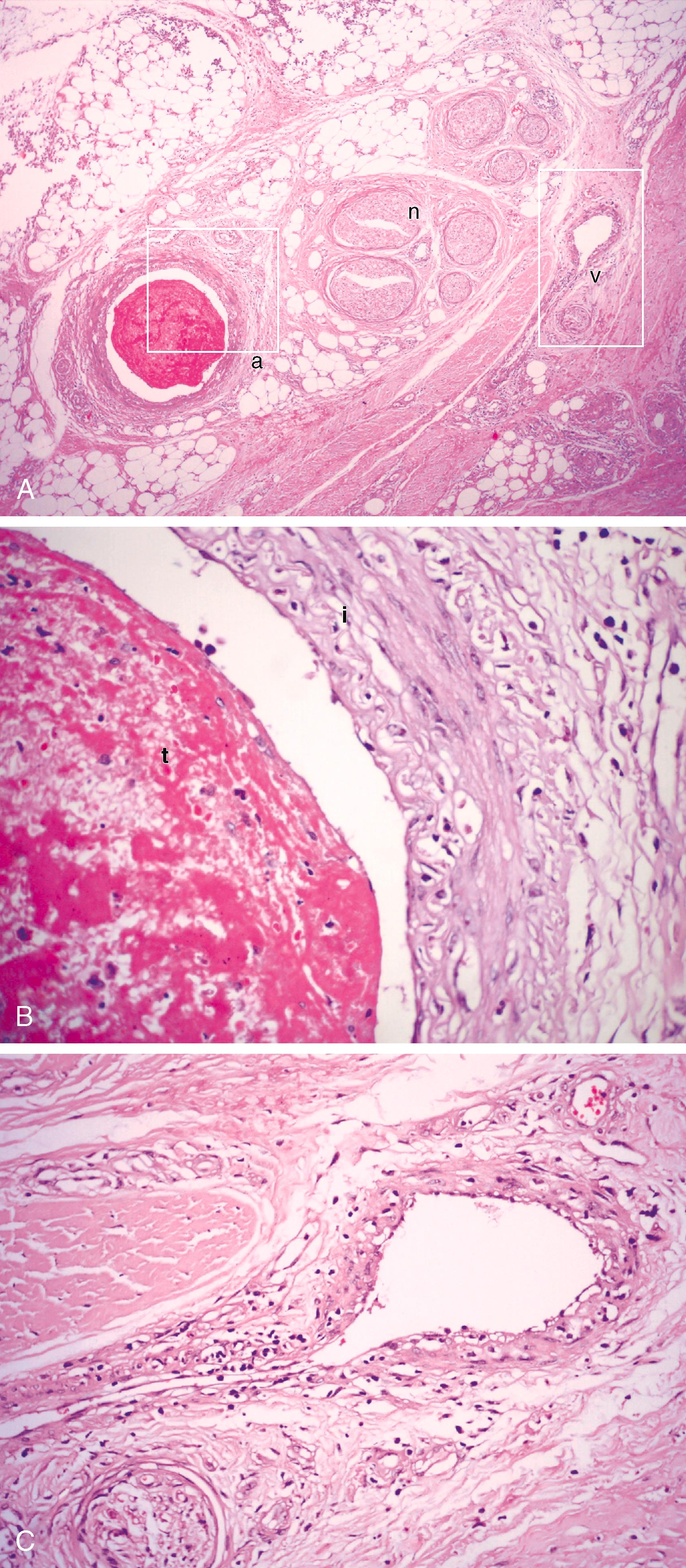
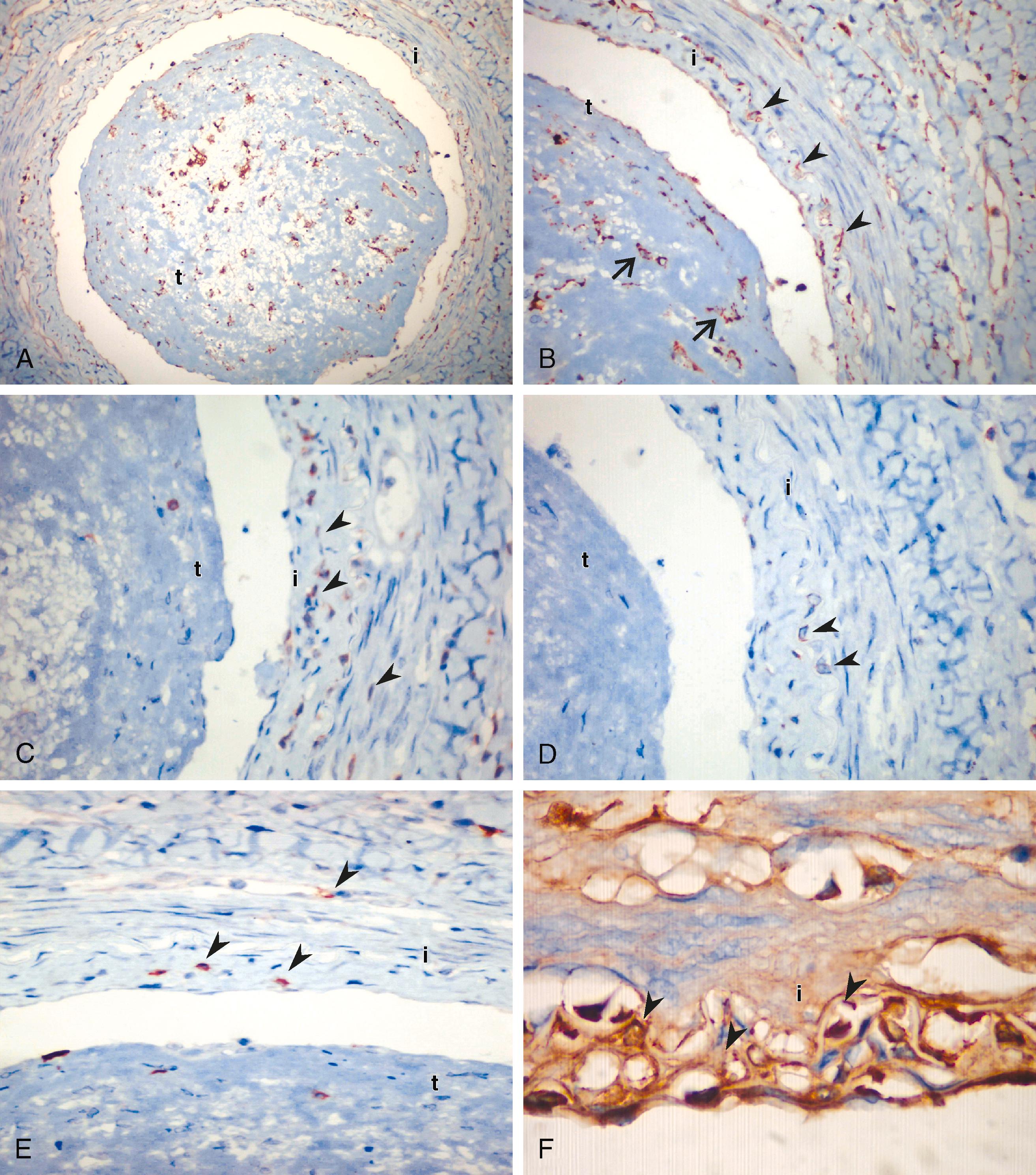
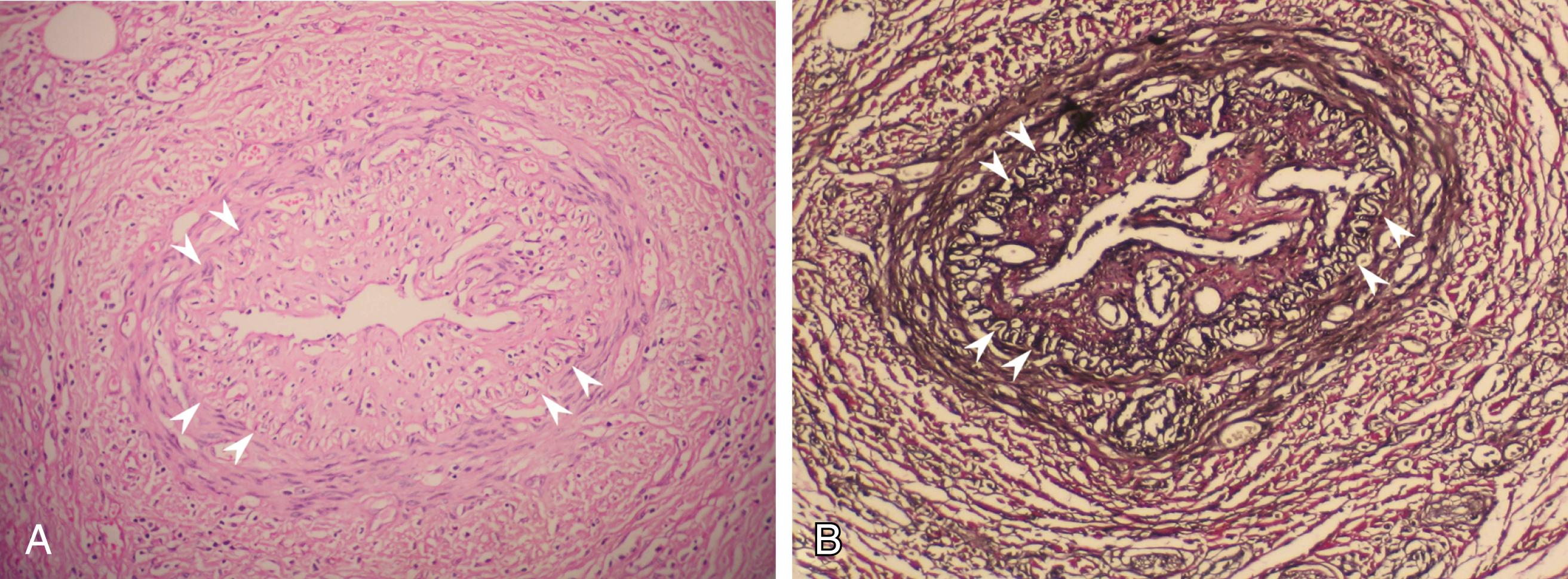
TAO usually presents with distal extremity ischemia in a smoker younger than 50 years old. , The median age at diagnosis is 34 years. , Characteristically, distal extremity ischemia involves the feet, legs, hands, or arms ( Fig. 139.4A and B ). As the disease progresses, it may affect more proximal arteries. Frequently identified signs and symptoms of TAO are listed in Table 139.1 . The most common symptoms are forefoot arch or lower calf claudication as a manifestation of infra-popliteal occlusive disease. Foot claudication is particularly characteristic. Foot or arch claudication may be misattributed to orthopedic problems. Early symptoms may include coldness or burning pain in the feet and hands, associated findings of dependent rubor, cyanosis, migratory superficial thrombophlebitis ( Fig. 139.4C ), , and Raynaud phenomenon. , , , Patients with TAO commonly report cold sensitivity, and sensory findings may be one of the earliest manifestations. In the Cleveland Clinic series published by Olin and colleagues, 69% of cases revealed sensory findings. Ischemic neuritis or superficial thrombophlebitis may also produce severe pain. Migrating phlebitis (phlebitis saltans) may occur as an early sign and has been reported in 40% to 65% of TAO patients during the course of the disease. , , Ascending venography and histological investigations suggest that 60% of the cases have venous involvement. Occasionally, superficial thrombophlebitis may extend into the deep venous system. However, deep venous thrombosis in Buerger disease is unusual. In the acute phase of the disease, involved vessels are tender and indurated and reflect the local inflammatory reaction.
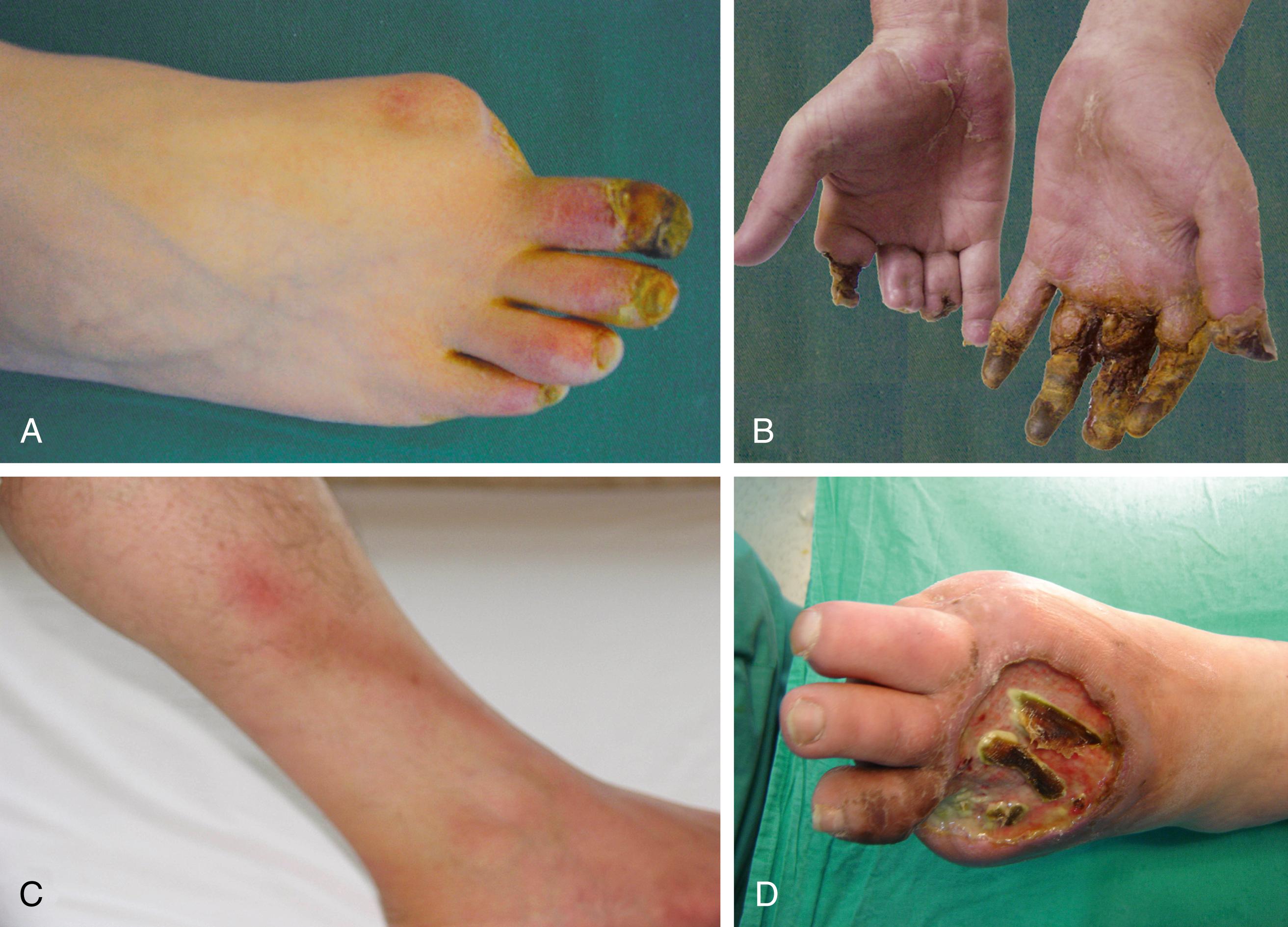
Late findings may present as trophic nail changes, ischemic ulcerations, and digital gangrene. , , , , , , Almost all ulcers occur in patients between the age of 20 and 50 years. Superinfection commonly develops, and the ischemic ulcerations progress toward necrosis and distal gangrene. At this stage, the pain is often excruciating. Ischemic ulcerations often appear dry and irregular, with a pale base and various shapes. , Joint manifestations – mainly transient, migratory episodes of large joint arthritis involving wrist and knees – may occur in approximately 12.5% of patients before the onset of digital ischemia. , , , Subungual splinter hemorrhages may be detected as an early sign. , , Coexisting psychological conditions are also common, primarily anxiety, depression, amputation, and unemployment-related fears. No difference in clinical presentation in women compared with men has been observed. ,
TAO does not occur in only one limb. Multiple limb involvement is a common feature of TAO. , , , , In the series reported by Shionoya, two limbs were affected in 16% of patients, three limbs in 41%, and all four limbs in 43% of patients. The Intractable Vasculitis Syndromes Research Group of Japan reported isolated lower extremity involvement in 75%, only upper extremity involvement in 5%, and both upper and lower extremity involvement in 20% of patients with TAO ( Table 139.2 ). Therefore, it is recommended that noninvasive imaging of all extremities be performed in patients with suspected TAO. , It is common to see angiographic abnormalities consistent with TAO in limbs that are not yet clinically involved. Rarely, TAO has been associated with visceral, cerebral, coronary, internal thoracic artery, , and multi-organ involvement. , The cerebral vessels’ involvement may result in progressive cognitive decline and migraine, transient ischemic attack, ischemic stroke, or schizophrenia-like symptoms. Coronary artery involvement may result in myocardial ischemia or infarction. Visceral vessel involvement may manifest as abdominal pain, nausea, vomiting, fever, diarrhea, melena, weight loss, and anorexia and result in ileus, ischemic colitis, mesenteric infarction, intestinal perforation, or liver hypoxia. , , , Involved vascular beds exhibit similar pathologic characteristics as vessels in the extremities. Even rarer, TAO instances in saphenous vein arterial grafts, the temporal arteries, the ophthalmic circulation, and intrarenal arterial branches of smokers have been reported. The occurrence of TAO in pudendal, , testicular, and spermatic arteries and veins, was too uncommon, as was initially described by Buerger. Rare cases of nephropathy as a result of mesangial immunoglobulin A deposition, or renal artery thrombosis; cutaneous manifestations presenting as painful nodular erythema with livedo reticularis, and avascular necrosis of femoral heads have also been reported. TAO in unusual locations should be diagnosed when the histopathologic findings are classic for the acute-phase lesion, and the clinical presentation is consistent with the diagnosis of TAO.
| Lower extremity involvement only | 616 (74.7%) |
| Upper and lower extremity arteries | 167 (20.2%) |
| Upper extremity involvement only | 42 (5.1%) |
| Lower extremity ( n = 783) | |
| Anterior tibial artery | 683 (41.4%) |
| Posterior tibial artery | 667 (40.4%) |
| Dorsalis pedis artery | 349 (21.2%) |
| Peroneal artery | 304 (18.4%) |
| Popliteal artery | 301 (18.2%) |
| Digital arteries | 180 (10.9%) |
| Plantar arteries | 149 (9.0%) |
| Other | 296 (19.8%) |
| Upper extremity ( n = 209) | |
| Ulnar artery | 189 (11.5%) |
| Digital arteries | 133 (8.1%) |
| Radial artery | 115 (7.0%) |
| Superficial or deep palmar arch | 75 (4.5%) |
| Brachial artery | 13 (0.8%) |
| Other | 26 (1.6%) |
After its first description, the primary clinical challenge in TAO is still the absence of universally accepted diagnostic criteria. , , Shionoya has identified five major criteria that are still valid for the diagnosis of TAO. , In 1996, Papa and colleagues proposed various clinical, angiographic, histopathologic positive and negative criteria, and in a second report, they introduced a point-based scoring system to improve the diagnostic certainty. , Mills and Porter developed more stringent major and minor supportive criteria on a cohort of patients in Oregon. Olin’s diagnostic criteria added the classification of ischemic limbs as claudication, pain at rest, ischemic ulcers, or gangrene and the consistency of arteriographic findings. , All investigators accepted the exclusion of atherosclerotic risk factors other than smoking. A comparative analysis of current diagnostic clinical criteria for TAO is summarized in Table 139.3 .
| Shionoya (Nagoya) , | Papa et al. (Tel Aviv) | Mills et al. (Oregon) , | Olin (Cleveland) , | |
|---|---|---|---|---|
| Age at onset | <50 years | <40 years | <45 years | <45 years |
| Smoking habit | Smoking history | Smoking history | Tobacco abuse | Current (or recent) history of tobacco use |
| Clinical manifestations |
|
|
|
|
| Diagnostic tests | Objective documentation of distal occlusive disease by
|
|
||
| Location of the disease | Infrapopliteal arterial occlusions | Distal disease | Distal disease Non-diseased arteries proximal to the popliteal or distal brachial level |
Distal extremity ischemia (infrapopliteal and/or infrabrachial) |
| Exclusion criteria | Atherosclerotic risk factors other than smoking | Arteriosclerosis obliterans, hypertension, diabetes mellitus, hyperlipidemia, proximal source of emboli, trauma, collagen disease and hypercoagulable states | Atherosclerosis (diabetes mellitus, hyperlipidemia, hypertension, renal failure), proximal source of emboli, trauma and local lesions, autoimmune disease, hypercoagulable states | Diabetes mellitus, autoimmune disease, connective tissue diseases, proximal source of emboli, hypercoagulable states |
A complete vascular examination is critical for the diagnosis. Physical examination reveals the involvement of medium and small-sized arteries with regular brachial and femoral pulses. The radial, ulnar, dorsalis pedis, or posterior tibial pulses may be absent. Digital arteries may be occluded. An abnormal Allen test, which suggests ulnar artery occlusion in a young smoker with lower extremity ulcerations, is highly suggestive of TAO. Abnormal Allen tests occurred in 63% of cases in the Cleveland Clinic series. Superficial phlebitis may be another clue to the diagnosis. Neurological examination may document peripheral nerve involvement, with sensory findings in up to 70% of patients. Calculation of the ankle–brachial index (ABI), toe–brachial index (TBI), and wrist–brachial index at rest and after exercise is recommended as the initial screening test. Seasonal variation, with exacerbation of TAO occurring more frequently in the winter, has been reported , ; this may be attributed to cold weather and the stimulation of vasospasm and Raynaud phenomenon.
Four-limb segmental arterial pressure measurements and pulse volume recordings are usually normal above the knee and markedly reduced distally. Abnormal digital plethysmographic patterns in both lower and upper extremities would objectively document distal occlusive disease in a patient meeting the clinical criteria for TAO. , , , , Calcification of the involved arterial wall is almost always absent on plain radiography. Arterial duplex scanning is used not only to exclude proximal atherosclerotic lesions and to demonstrate distal arterial occlusive disease but also to visualize and functionally evaluate the corkscrew-shaped collaterals. Using continuous wave Doppler ultrasound monophasic waveform pattern within the corkscrew-shaped collaterals is also known as Martorell’s sign (“snake” or “dot” sign) ( Fig. 139.5 ). These findings indicate selective impairment of vascular endothelium, but not smooth muscle cells in native arteries in patients with TAO. Besides, superb microvascular imaging may have a role in the identification and classification of corkscrew collaterals. Furthermore, blood flow patterns within the corkscrew collateral arteries using computational fluid dynamics simulation from CT-angiography images may help a better understanding of the disease progression. Laser Doppler flowmetry, transcutaneous oxygen, and carbon dioxide pressures can be useful to evaluate the severity of ischemia and the effectiveness of treatment.
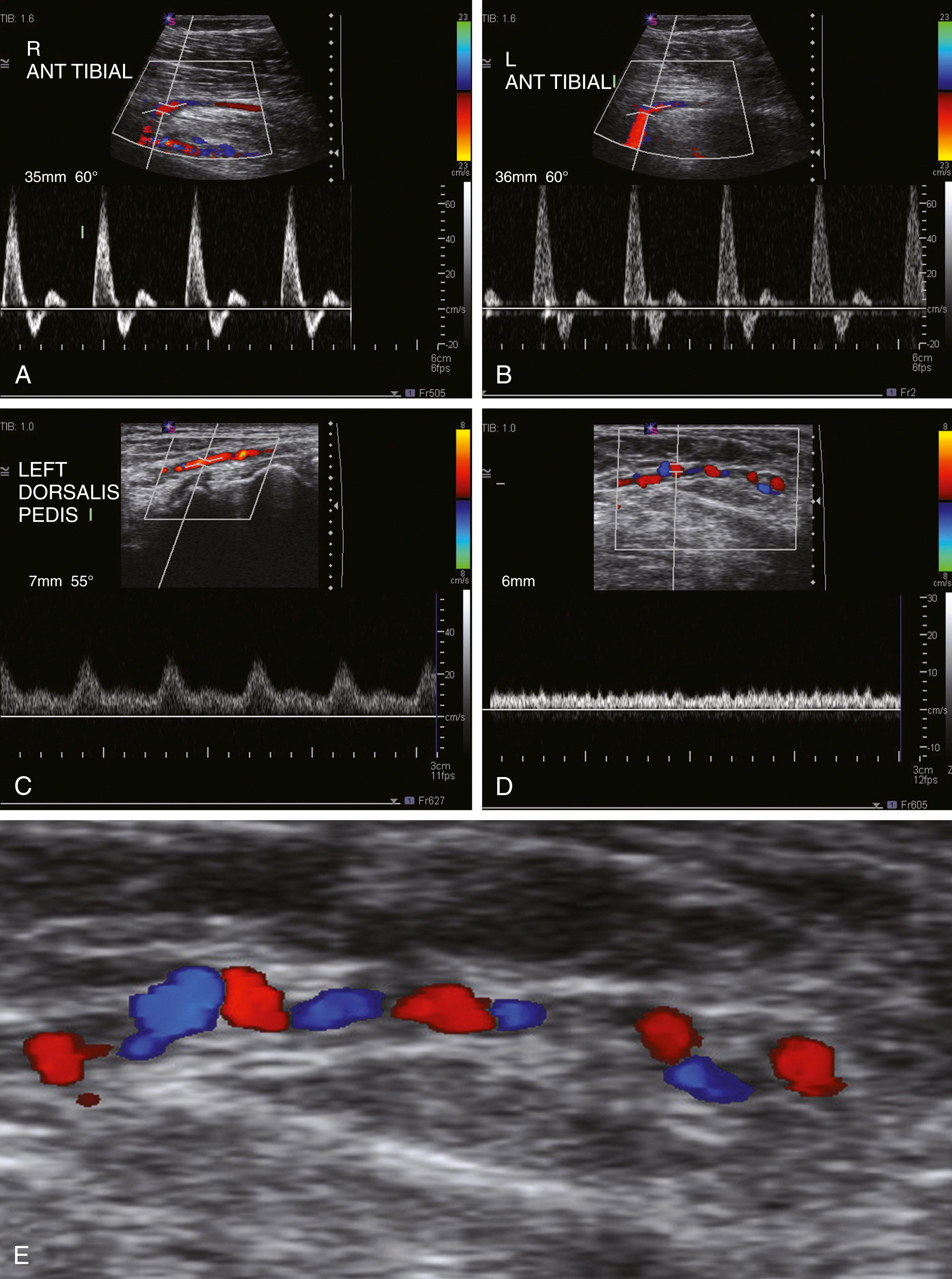
Emboli as a cause of distal ischemia should be ruled out, as the signs and symptoms of embolic occlusions can mimic those of TAO. Cardiac investigations, including electrocardiography, rhythm monitoring, and echocardiography, are recommended to rule out cardiac and thoracic aortic sources of emboli to the involved extremity. Abdominal ultrasonography may be considered to rule out a proximal source of emboli from an abdominal aortic aneurysm or atherosclerotic aorta.
Gadolinium-enhanced magnetic resonance angiography and multidetector computed tomographic angiography ( Fig. 139.6 ) may be useful diagnostic alternatives in patients with TAO. Furthermore, ischemic ulcerations with signs and symptoms of secondary infection should be evaluated using conventional radiography and magnetic resonance imaging to determine osteomyelitis. Recently, 18F-fluorodeoxyglucose positron emission tomography has been investigated in TAO case series but found to be an unsuitable investigative procedure for the diagnosis of TAO.
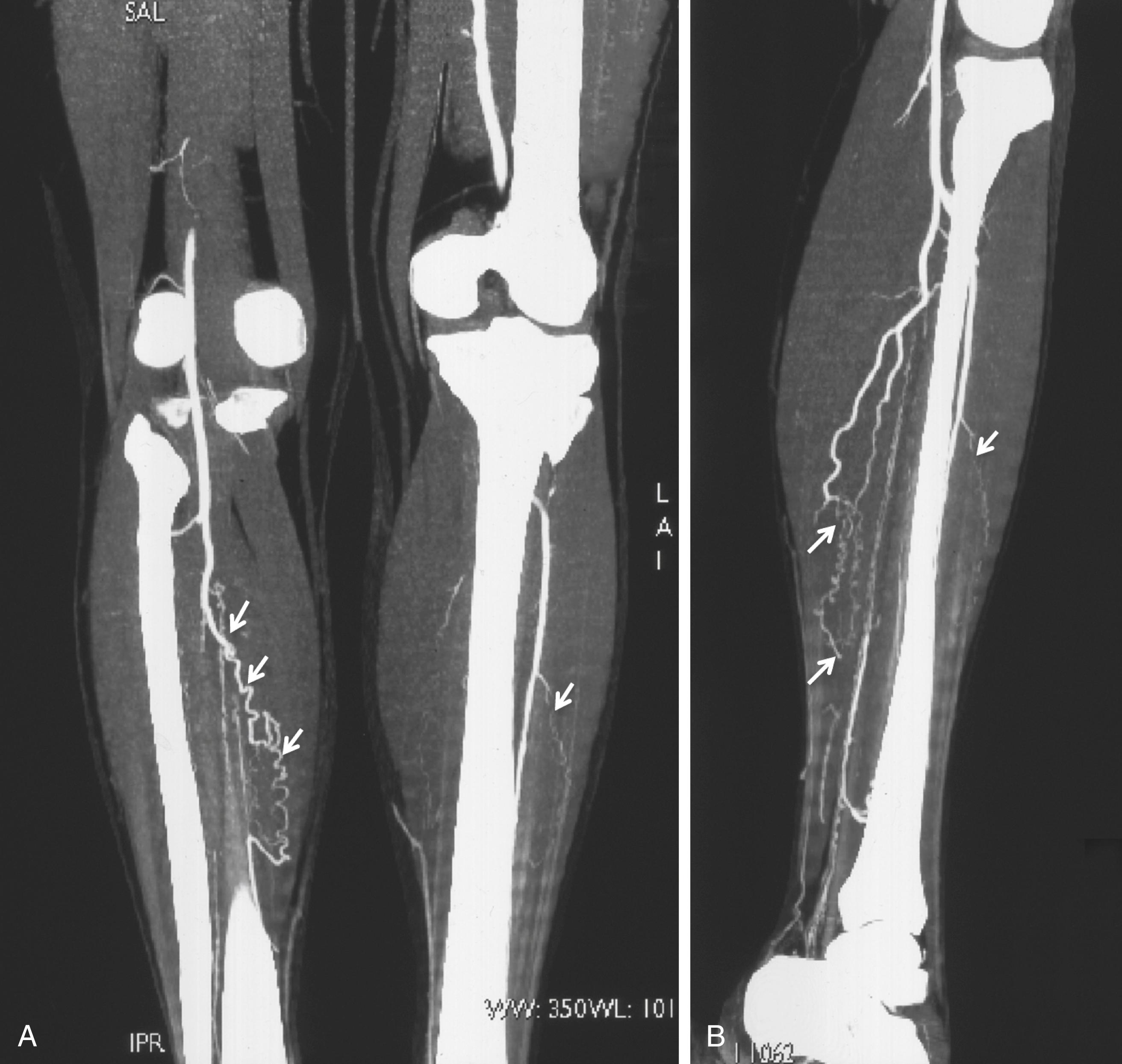
Become a Clinical Tree membership for Full access and enjoy Unlimited articles
If you are a member. Log in here